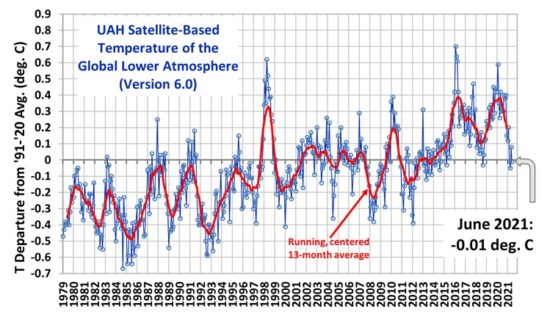The Version 6.0 global average lower tropospheric temperature (LT) anomaly for June, 2021 was -0.01 deg. C, down from the May, 2021 value of +0.08 deg. C.
REMINDER: We have changed the 30-year averaging period from which we compute anomalies to 1991-2020, from the old period 1981-2010. This change does not affect the temperature trends.
The linear warming trend since January, 1979 remains at +0.14 C/decade (+0.12 C/decade over the global-averaged oceans, and +0.18 C/decade over global-averaged land).
Various regional LT departures from the 30-year (1991-2020) average for the last 18 months are:
YEAR MO GLOBE NHEM. SHEM. TROPIC USA48 ARCTIC AUST
2020 01 0.42 0.44 0.40 0.52 0.57 -0.22 0.41
2020 02 0.59 0.74 0.45 0.63 0.17 -0.27 0.20
2020 03 0.35 0.42 0.27 0.53 0.81 -0.96 -0.04
2020 04 0.26 0.26 0.25 0.35 -0.70 0.63 0.78
2020 05 0.42 0.43 0.41 0.53 0.07 0.83 -0.20
2020 06 0.30 0.29 0.30 0.31 0.26 0.54 0.97
2020 07 0.31 0.31 0.31 0.28 0.44 0.27 0.26
2020 08 0.30 0.34 0.26 0.45 0.35 0.30 0.24
2020 09 0.40 0.41 0.39 0.29 0.69 0.24 0.64
2020 10 0.38 0.53 0.22 0.24 0.86 0.95 -0.01
2020 11 0.40 0.52 0.27 0.17 1.45 1.09 1.28
2020 12 0.15 0.08 0.22 -0.07 0.29 0.44 0.13
2021 01 0.12 0.34 -0.09 -0.08 0.36 0.49 -0.52
2021 02 0.20 0.32 0.08 -0.14 -0.65 0.07 -0.27
2021 03 -0.01 0.13 -0.14 -0.29 0.59 -0.78 -0.79
2021 04 -0.05 0.05 -0.15 -0.28 -0.02 0.02 0.29
2021 05 0.08 0.14 0.03 0.06 -0.41 -0.04 0.02
2021 06 -0.01 0.30 -0.32 -0.14 1.44 +0.63 -0.76
Despite the near-normal global average temperatures, the USA Lower 48 temperature anomaly of +1.44 deg. C was the warmest in the 43 year satellite record, ahead of +1.15 deg. C in 1988. In contrast, the Antarctic region (poleward of 60 S latitude) experienced its 2nd coldest June (-1.25 deg. C below the 30-year baseline), behind -1.34 deg. C in June, 2017.
The full UAH Global Temperature Report, along with the LT global gridpoint anomaly image for June, 2021 should be available within the next few days here.
The global and regional monthly anomalies for the various atmospheric layers we monitor should be available in the next few days at the following locations:
Lower Troposphere: http://vortex.nsstc.uah.edu/data/msu/v6.0/tlt/uahncdc_lt_6.0.txt
Mid-Troposphere: http://vortex.nsstc.uah.edu/data/msu/v6.0/tmt/uahncdc_mt_6.0.txt
Tropopause: http://vortex.nsstc.uah.edu/data/msu/v6.0/ttp/uahncdc_tp_6.0.txt
Lower Stratosphere: http://vortex.nsstc.uah.edu/data/msu/v6.0/tls/uahncdc_ls_6.0.txt

 Home/Blog
Home/Blog





This is so great article! I like the way this blog was organized and presented. This is really informative. Thanks for a great information!
https://electriciangreystanes.com.au/
This is so great article! I like the way this blog was organized and presented. This is really informative. Thanks for a great information! electrician Greystanes
appreciate it a great deal this excellent website is conventional
and informal
Also visit my homepage :: נערתליווייווי
And always, always the same mmanipulation
” When Newton used the term revolving on its axis, he obviously meant the Moon was revolving about the Earth as its axis. ”
made by insidiously taking a portion of Newton’s wording out of its context:
” Jupiter revolvitur horis 9. 56′, Mars horis 24. 39′. Venus horis 23. circiter, Terra horis 23. 56′, Sol diebus 25 1/2, et Luna diebus 27 7 hor. 43′ ”
Thus, when Newton mentions Earth and writes : ” Terra horis 23. 56′ “, he of course means Earth’s rotation about its axis, exactly like for Jupiter, Mars, Venus… and the Sun.
But, but… according to Robertson, the ignorant denialist-in-chief, when Newton mentions the Moon and writes ” et Luna diebus 27. 7. hor. 43′ “, he of course means Moon’s orbit around Earth!
And that in one and the same sentence!
It’s as if Robertson were making us think that Newton was a moron at the time he wrote what we’re discussing.